Fact of Fiction? The Legend of the QWERTY Keyboard
What came first: the typist or the keyboard? The answer may surprise you
/https://tf-cmsv2-smithsonianmag-media.s3.amazonaws.com/filer/66/ee/66ee08a6-8daa-408c-9f11-0927f5b8cfa6/sholes-qwerty-patent.jpg)
What came first: the typist or the keyboard? The answer depends on the keyboard. A recent article in Smithsonian’s news blog, Smart News, described an innovative new keyboard system that proposes a more efficient alternative to the ubiquitous “universal” keyboard best known as QWERTY – named for the first six letters in the top row of keys. The new keyboard, known as KALQ, is designed specifically for thumb-typing on today’s smart phones and tablets. It’s an interesting and by all accounts commercially viable design that got me thinking about the rationale behind the QWERTY keyboard. Unlike KALQ, it couldn’t have been designed to accommodate a specific typing technique because, well, the idea of typing –touch typing, at least– hadn’t been invented yet. It turns out that there is a lot of myth and misinformation surrounding the development of QWERTY, but these various theories all seem to agree that the QWERTY layout was developed along with, and inextricably linked to, early typewriters.
In the 1860s, a politician, printer, newspaper man, and amateur inventor in Milwaukee by the name of Christopher Latham Sholes spent his free time developing various machines to make his businesses more efficient. One such invention was an early typewriter, which he developed with Samuel W. Soulé, James Densmore, and Carlos Glidden, and first patented in 1868. The earliest typewriter keyboard resembled a piano and was built with an alphabetical arrangement of 28 keys. The team surely assumed it would be the most efficient arrangement. After all, anyone who used the keyboard would know immediately where to find each letter; hunting would be reduced, pecking would be increased. Why change things? This is where the origin of QWERTY gets a little foggy.
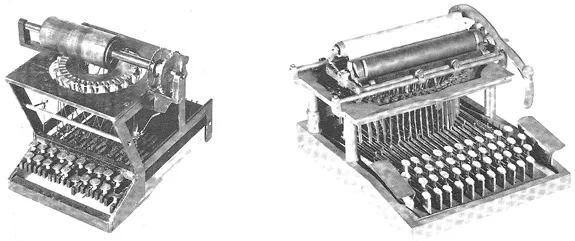
The popular theory states that Sholes had to redesign the keyboard in response to the mechanical failings of early typewriters, which were slightly different from the models most often seen in thrift stores and flea markets. The type bars connecting the key and the letter plate hung in a cycle beneath the paper. If a user quickly typed a succession of letters whose type bars were near each other, the delicate machinery would get jammed. So, it is said, Sholes redesigned the arrangement to separate the most common sequences of letters like “th” or “he”. In theory then, the QWERTY system should maximize the separation of common letter pairings. This theory could be easily debunked for the simple reason that “er” is the fourth most common letter pairing in the English language. However, one of the typewriter prototypes had a slightly different keyboard that was only changed at the last minute. If it had been put into production this article would have been about the QWE.TY keyboard:
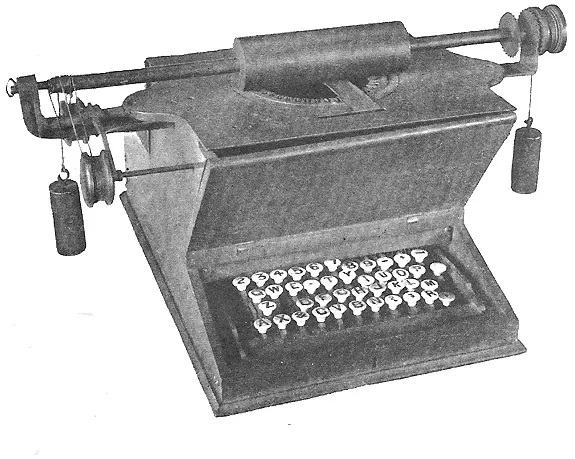
By 1873, the typewriter had 43 keys and a decidedly counter-intuitive arrangement of letters that supposedly helped ensure the expensive machines wouldn’t break down. Form follows function and the keyboard trains the typist. That same year, Sholes and his cohorts entered into a manufacturing agreement with gun-maker Remington, a well-equipped company familiar with producing precision machinery and, in the wake of the Cilvil War, no doubt looking to turn their swords into plowshares. However, right before their machine, dubbed the Sholes & Glidden, went into production, Sholes filed another patent, which included a new keyboard arrangement. Issued in 1878, U.S. Patent No. 207,559 (top image) marked the first documented appearance of the QWERTY layout. The deal with Remington proved to be an enormous success. By 1890, there were more than 100,000 QWERTY-based Remington produced typewriters in use across the country. The fate of the keyboard was decided in 1893 when the five largest typewriter manufacturers –Remington, Caligraph, Yost, Densmore, and Smith-Premier– merged to form the Union Typewriter Company and agreed to adopt QWERTY as the de facto standard that we know and love today.
There’s a somewhat related theory that credits Remington’s pre-merger business tactics with the popularization of QWERTY. Remington didn’t just produce typewriters, they also provided training courses – for a small fee, of course. Typists who learned on their proprietary system would have to stay loyal to the brand, so companies that wanted to hire trained typists had to stock their desks with Remington typewriters. It’s a system that’s still works today, as illustrated by the devout following Apple built through the ecosystem created by iTunes, the iTunes store, and the iPod.
While it can’t be argued that deal with Remington helped popularize the QWERTY system, its development as a response to mechanical error, has been questioned by Kyoto University Researchers Koichi Yasuoka and Motoko Yasuoka. In a 2011 paper, the researchers tracked the evolution of the typewriter keyboard alongside a record of its early professional users. They conclude that the mechanics of the typewriter did not influence the keyboard design. Rather, the QWERTY system emerged as a result of how the first typewriters were being used. Early adopters and beta-testers included telegraph operators who needed to quickly transcribe messages. However, the operators found the alphabetical arrangement to be confusing and inefficient for translating morse code. The Kyoto paper suggests that the typewriter keyboard evolved over several years as a direct result of input provided by these telegraph operators. For example;
“The code represents Z as ‘· · · ·’ which is often confused with the digram SE, more frequently-used than Z. Sometimes Morse receivers in United States cannot determine whether Z or SE is applicable, especially in the first letter(s) of a word, before they receive following letters. Thus S ought to be placed near by both Z and E on the keyboard for Morse receivers to type them quickly (by the same reason C ought to be placed near by IE. But, in fact, C was more often confused with S).
In this scenario, the typist came before the keyboard. The Kyoto paper also cites the Morse lineage to further debunk the theory that Sholes wanted to protect his machine from jamming by rearranged the keys with the specific intent to slow down typists:
“The speed of Morse receiver should be equal to the Morse sender, of course. If Sholes really arranged the keyboard to slow down the operator, the operator became unable to catch up the Morse sender. We don’t believe that Sholes had such a nonsense intention during his development of Type-Writer.”
Regardless of how he developed it, Sholes himself wasn’t convinced that QWERTY was the best system. Although he sold his designs to Remington early on, he continued to invent improvements and alternatives to the typewriter for the rest of his life, including several keyboard layouts that he determined to be more efficient, such as the following patent, filed by Sholes in 1889, a year before he died, and issued posthumously:
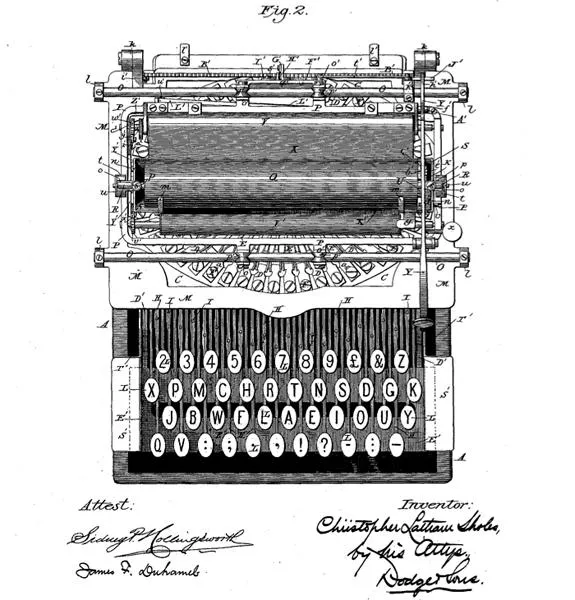
But the biggest rivals to ever challenge QWERTY is the Dvorak Simplified Keyboard, developed by Dr. August Dvorak in the 1930s.
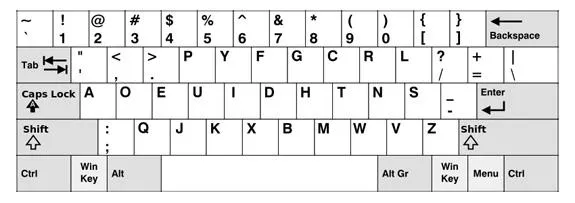
Dvorak users reported faster and more accurate typing, in part because the system dramatically increases the number of words that can be typed using the “home” row of keys where your fingers naturally rest – also known as the keys you type when you’re just trying fill space. asjdfkal; sdfjkl; asdfjkl; asdfjkl; dkadsf. asdfjklasdfjk. More recent research has debunked any claims that Dvorak is more efficient, but it hardly matters. Even in 1930 it was already too late for a new system to gain a foothold. While Dvorak certainly has its champions, it never gained enough of a following to overthrow King QWERTY. After all, the world learned to type using Remington’s keyboard.
When the first generation of computer keyboards emerged, there was no longer any technical reason to use the system – computers didn’t get jammed. But of course, there’s the minor fact that millions of people learned to type on the QWERTY keyboards. It had become truly ubiquitous in countries that used the Latin alphabet. Not only that, but way back in 1910, the system had been adopted by Teletype, a company that would go on to produce electronic typewriters and computer terminals widely used around the world, thereby ensuring QWERTY’s place as the new technological standard.
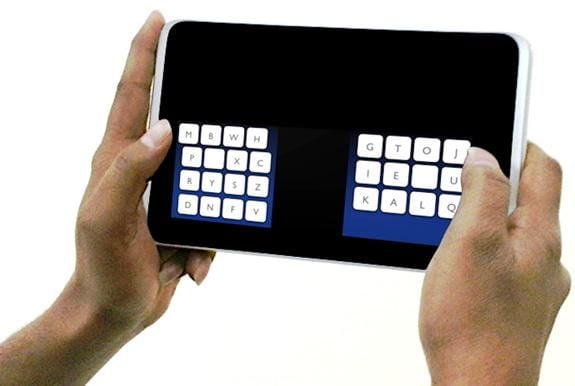
When a design depends on a previous innovation too entrenched in the cultural zeitgeist to change, it’s known as a path dependency. And this why the new KALQ proposal is so interesting. It attempts to break from the tyranny of Christopher Latham Sholes, whose QWERTY system makes even less sense on the virtual keyboards of tablets and smartphones than it does on a computer keyboards. Is the new KALQ system any different? In some ways, the answer is obviously yes. It has been designed around a very specific, very modern behavior – typing with thumbs. Like the telegraph operator QWERTY theory, the user is determining the structure of the keyboard. But it could still be argued that the KALQ system, or any similar system that may be developed in the future, is also a product of path dependency. Because no matter how the letters are arranged, they basic notion of individually separated letters distributed across a grid dates back to Sholes and co. tinkering away in their Milwaukee workshops. But it’s just not necessary in a tablet. If you gave an iPad to someone who had never used a keyboard and told them to develop a writing system, chances are they would eventually invent a faster, more intuitive system. Perhaps a gesture based system based on shorthand? Or some sort of swipe-to-type system? This is not to say that such a system would be better, it’s merely an observation that our most bleeding edge communication technology still dates back more than 150 years to some guys tinkering in their garage. Truly, the more things change, the more they stay the same.
/https://tf-cmsv2-smithsonianmag-media.s3.amazonaws.com/accounts/headshot/Jimmy-Stamp-240.jpg)
/https://tf-cmsv2-smithsonianmag-media.s3.amazonaws.com/accounts/headshot/Jimmy-Stamp-240.jpg)